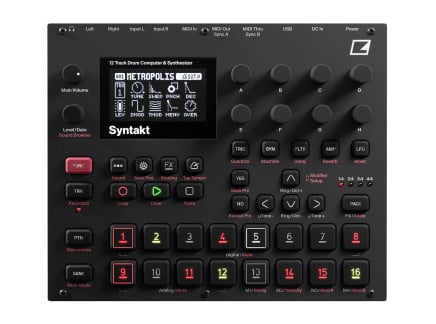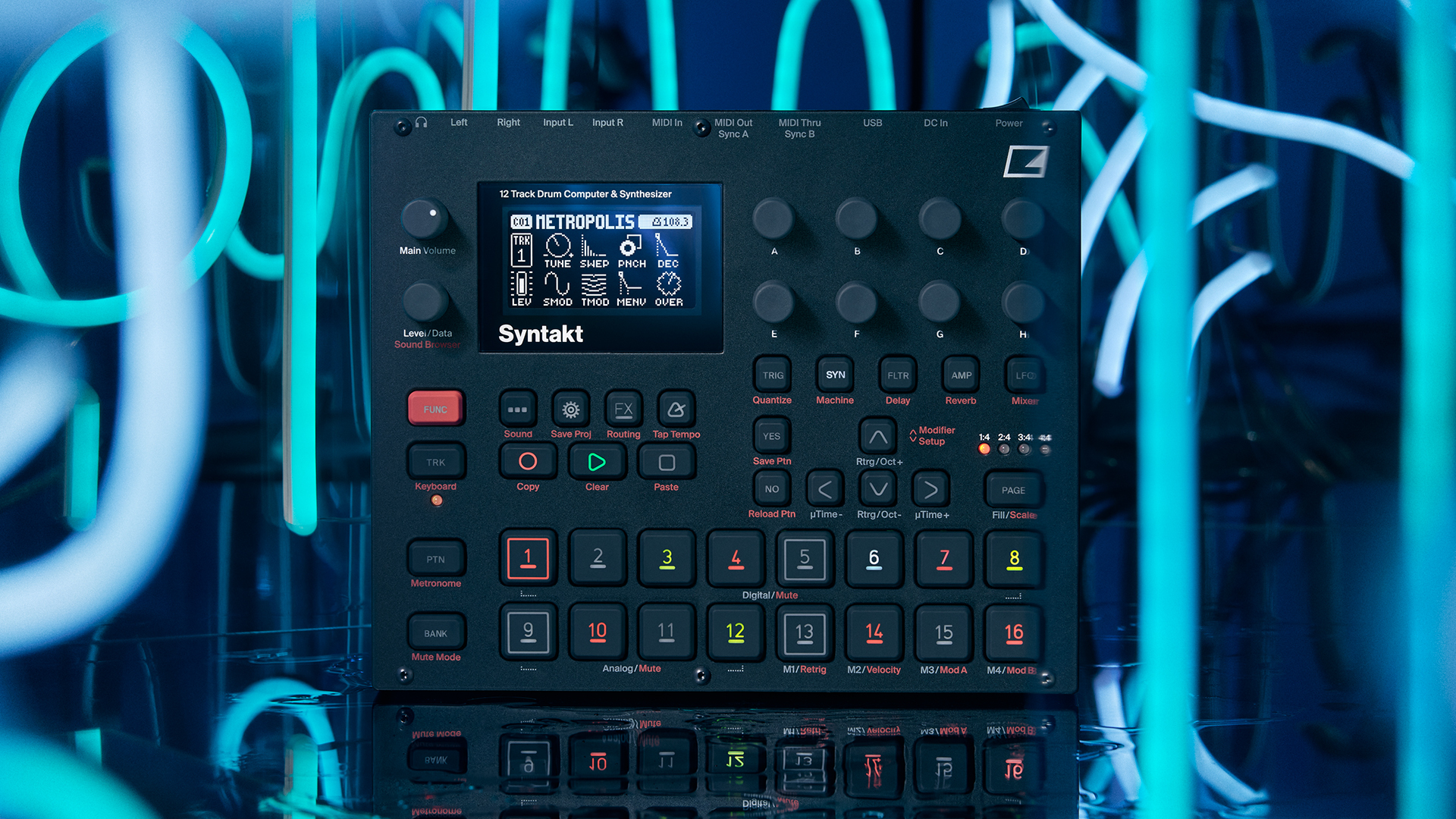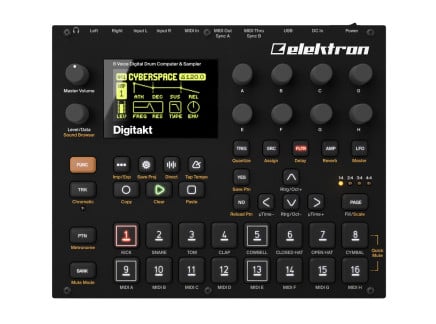After a couple of quiet years, Elektron's latest instrument is finally here: Syntakt, the 12 Track Drum Computer and Synthesizer with capabilities for both analog and digital synthesis. This hybrid drum machine / groovebox is the third member of the beloved Digi-series, following the Digitakt sampler and Digitone FM synthesizer, and it perfectly completes the trio with its focus on powerful drum synthesis and live performance.
Here at Perfect Circuit, we have a lot of reasons to be excited for Syntakt, and we seriously think it's one of the best Elektron boxes to date. In some ways, Syntakt is a culmination of Elektron's design philosophies over the last 20+ years, yet it also brings plenty of fresh ideas to the table. Every Elektron instrument is deep, and there's a lot to be unpacked when a new one rolls out—and boy, did they pack a lot into Syntakt.
Ready to dive in? Check out our video above for a rippin' performance by our pal Baseck, and keep reading this article to get yourself up to speed on Syntakt.
The Road to Syntakt
Elektron is relentlessly forward-thinking in their instrument design, and anytime they revisit a concept from a previous product, it's always refined and improved upon from the last time we saw it. And with such a stellar track record, there was a rich legacy to draw from in designing the Syntakt. As a result, Syntakt feels like the crown jewel of the Digi instruments—the de facto flagship of its series.
Perhaps most obviously, Syntakt looks and functions a lot like its most immediate sibling Digitakt, though it relies on synthesis for its drum machine sound palette rather than sampling. At its core, Syntakt is a Digi-format instrument, and subscribes to the same streamlined menu structuring, organizational systems, and parameterization style as Digitakt and Digitone. Within a single Project, 128 Patterns store just about all of the information for all 12 tracks, including sound and sequencer settings. There's a Sound Pool per Project, which keeps 128 different sounds accessible across all patterns, and may be called upon through the sequencer on a per-step basis via sound locks. On top of this, Syntakt also supports full Overbridge compatibility, and can function as a class-compliant USB audio interface with computers, phones, and tablets—just like the other Digi units.

When it comes to generating sound, Syntakt provides a total of 12 tracks, divided into eight digital tracks and four analog tracks. This isn't the first time Elektron has created a hybrid instrument with both analog and digital elements—namely, Analog Four's LFOs, envelope generators, and effects are digital, while Analog Rytm also allows for samples to be layered with analog drums. But this is the first time they've made a hybrid instrument totally focused on drum synthesis, and that leads to a lot of interesting creative considerations. Having access to analog and digital variations of similar sounds at the same time allows for more nuanced construction of sequences, and if all tracks of one type are tied up, you can reliably fall back on the other to fill any given role.
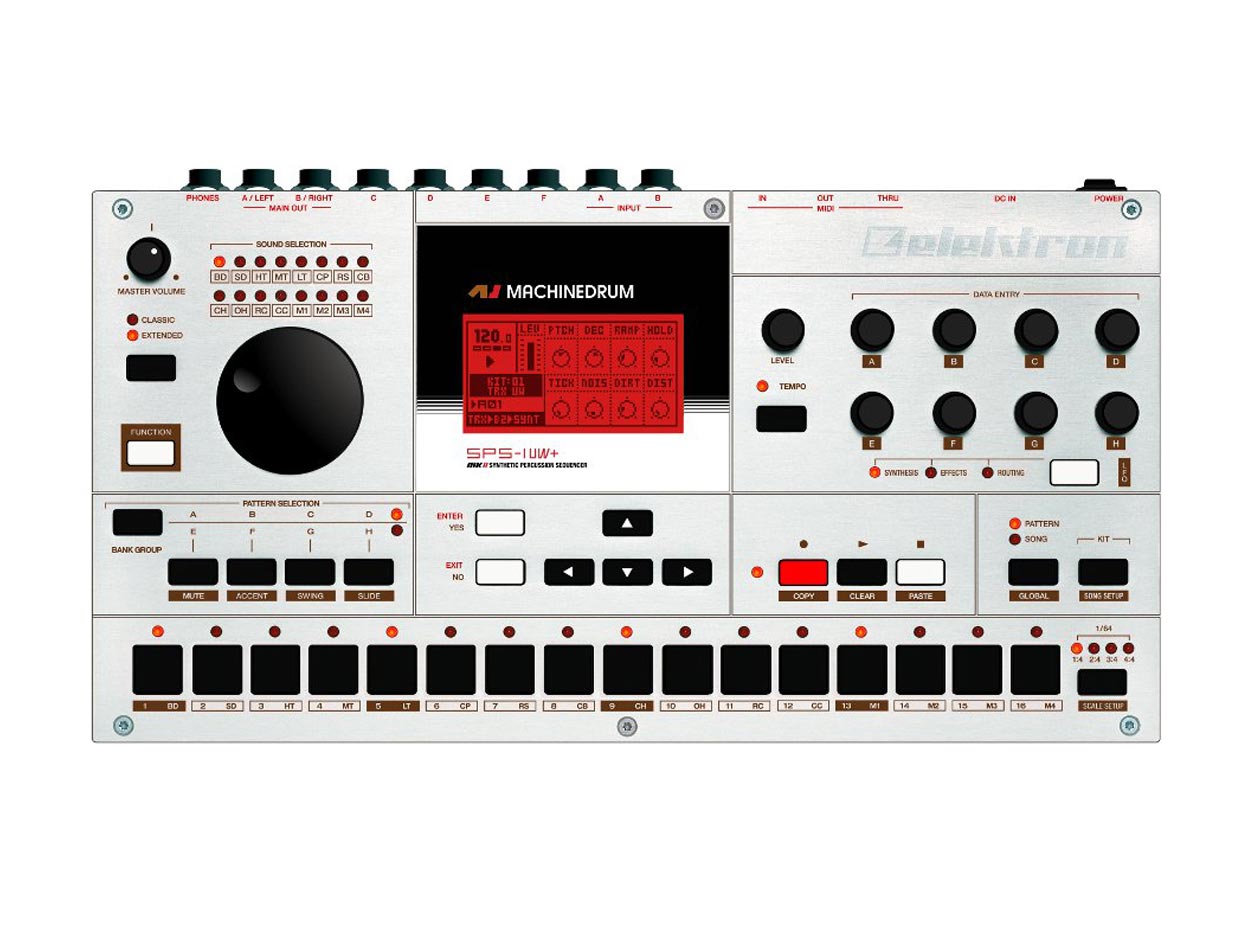 Elektron's Machinedrum
Elektron's Machinedrum
On the side of digital drums, Syntakt is the symbolic mighty tree which grew from where Elektron laid their roots over two decades ago. When the Machinedrum rolled out in 2001, it introduced the world to the Elektron sequencer and outlined the frame that every future Elektron product would build upon. It was also packed with a number of stellar digital synthesis methods, which combined with the sequencer could yield an astonishing variety of musical results. Though it went through a few iterations in its production lifetime, Elektron really didn't return to digital drum-focused synthesis—not counting sampling—until the Model:Cycles came out in early 2020. So while it certainly draws inspiration from both the Cycles and Machinedrum, it should be emphasized that Syntakt has its own sonic identity.
Syntakt also shows that Elektron is still very capable of flexing their analog side, too. While they had made a name for themselves as masters of digital instrument design, the Analog Four's release in 2012 showed that tight digital control and sequencing of analog circuitry was its own world to explore. Then just a couple of years later, Analog Rytm brought punchy analog drums supplemented by samples. While Syntakt doesn't have sampling capabilities, the ability to combine analog with digital voices is the core of its immense, varied, and generally phenomenal sound.
Of course, sound is merely one piece of the Syntakt puzzle, as any great modern drum machine should also be highly performable. The inclusion of the Elektron sequencer is a given, fully-loaded with its ability to modify most parameters, apply probabilities, or even change sounds entirely on a per-step basis. But as we run down what Syntakt has to offer, you'll see that it has some other tricks up its sleeve, too.
What Are Machines?
Before we get into the specifics of what Elektron packed into the Syntakt, it's important to have an understanding of what they call "Machines." You can think of a Machine as a defined function for a track, with parameters laid out in such a way that makes sense for its intended musical application. Typically, these are going to be a certain type of sound engine, with different types of Machines available for the various analog and digital tracks, and designed for things like bass and snare drums, cymbals, or even melodies and chords. Machines are a fundamental Elektron concept that can be traced all the way back to the release of the aptly-named Machinedrum, and have returned in various forms in a number of different Elektron instruments over the years, including the Monomachine, Octatrack, Analog Rytm, and more recently, Model:Cycles.
In total, Syntakt generously offers over 30 different types of Machines, meaning that there are plenty of options at your disposal for any given musical goal. And while a Machine might be predisposed for crafting punchy kicks or snares, Elektron built a lot of workable range into the various parameters, so there are sure to be compelling sounds found in unexpected places. This is especially true of the Digital Machines, where a single parameter can radically transform the sound across its range. On top of this, most Machines work great with either an AHD (Attack, Hold, Decay) or ADSR (Attack, Decay, Sustain, Release) envelope—turn the Hold parameter to its maximum or use an ADSR and you could start playing "Drums" as if they were a traditional synth voice, creating unusual instruments for melodies, basses, and more.
Even from a user interface standpoint, Elektron made a point to design clever animations to convey parameter values, rather than just a plain number that doesn't otherwise convey any information about how something sounds. But by animating a waveform or using some other visualizations through diagrams or cute characters, it's much easier to immediately glance at any page and have some intuition about what's going on. Some of our favorites that we've found across Syntakt include the UFO pilot in the CY Alloy Machine, as well as the little creatures in SY Chord.
 Entering orbit to craft some interstellar beats
Entering orbit to craft some interstellar beats
Elektron power users might already be looking at Syntakt and brainstorming a number of ways to maximize their usage of tracks. While Machine selection occurs on one of the secondary parameter pages, thus making it unavailable to Parameter Locks (that is, changing the Machine on a per-step basis with the sequencer), you can access the different Machines through the Sound Pool and Sound Locks. This is always one of my favorite things to do on any Elektron device—when one or more tracks are tied up doing specific musical tasks, sound locks on another can provide the illusion of generating more voices than you actually have. This is also your ticket to designing linear drum patterns and fills, where multiple drum voices aren't being triggered at the same time.
Finally, it should be noted that in order to use a track strictly for MIDI sequencing, one must simply assign a MIDI Machine to it. When this is done, the track will no longer be able to generate sound and is purely used for transmitting data from the 5-pin DIN or USB ports. This might appear to be a limitation, but remember that with multiples of almost every track type and the availability of Sound Locks, losing a small subset of voices for MIDI sequencing can be compensated for without too much difficulty. Plus, Elektron boxes have long been held in high regard for using their sequencers to control other instruments.
The Syntakt's Digital Voices
Out of the 12 tracks on Syntakt, the first eight of them are fully digital voices, and as of launch there are ten different types of Machines that may be freely assigned to any combination of those tracks. Being that Syntakt is primarily labeled as a "Drum Computer" it should be no surprise that most of those machines are drum oriented, ranging from kicks and snares to various cymbals and miscellaneous digital percussion sounds. There are also two general purpose synthesis Machines that are more immediately suitable for melodic and harmonic content, but you'll soon see that all Machines are very capable of achieving sounds that are well beyond their intended use.

For the Machines designed with drums in mind, Syntakt primarily employs FM synthesis for sound generation. These machines are a bit inspired by the Model:Cycles, but Elektron didn't simply copy and paste those sounds into Syntakt—these are greatly expanded and much more versatile Machines that were built from the ground up for this instrument. And compared to the Digitone, which is certainly capable of creating drum sounds, Syntakt makes life a bit easier for you and builds a lot of more immediately useful percussion parameters into the core of the Machine. Quality-of-life things like separate Pitch Sweep and Modulation envelopes make the creation process that much more immediate and gratifying, leading to better music faster.
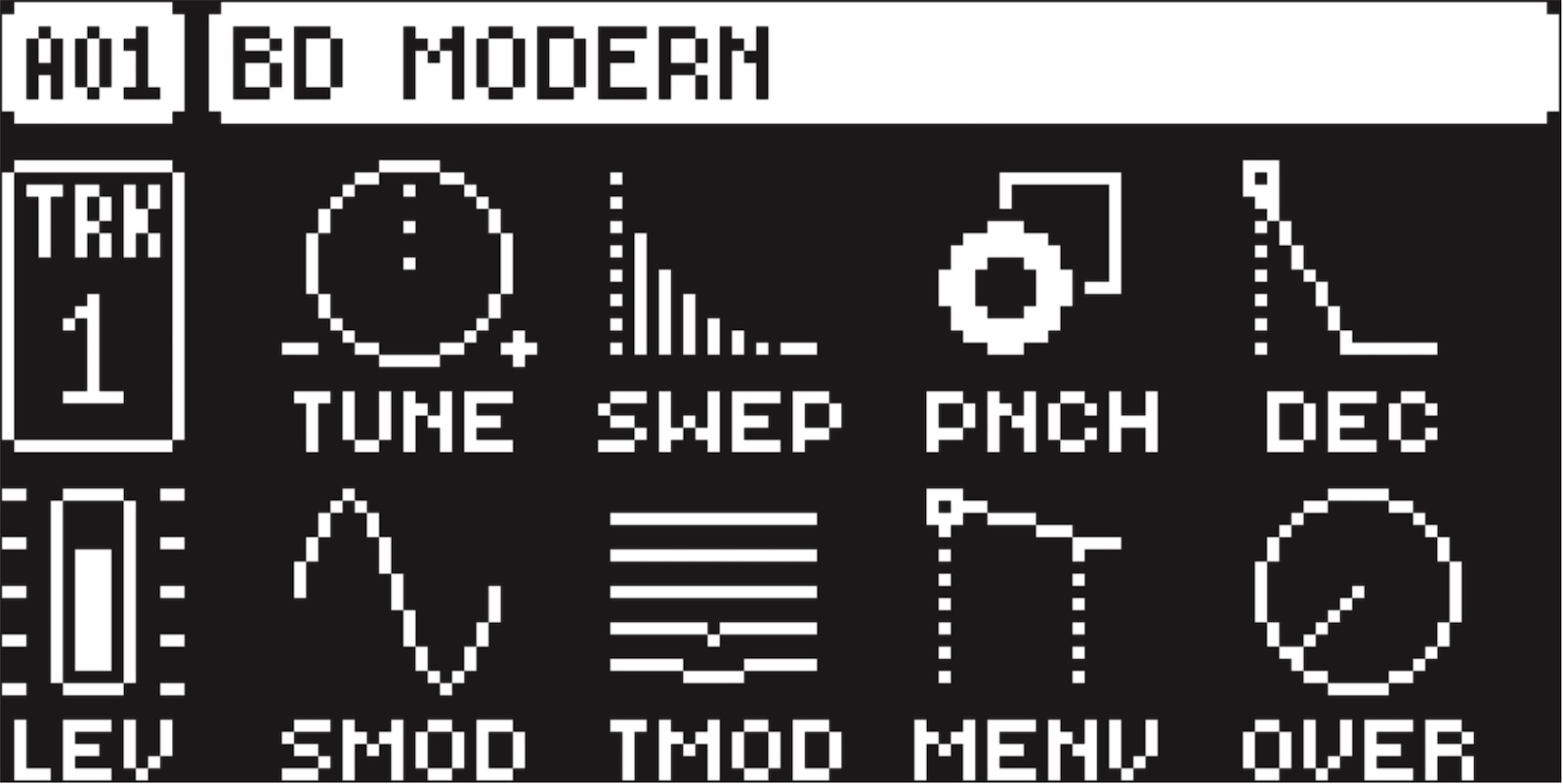 Syntakt's Digital BD Modern Machine
Syntakt's Digital BD Modern Machine
On that note, while we knew they would be good, we were pleasantly surprised at how seriously punchy and powerful the digital drums sound, even alongside the analog voices. While you might assume that the analog tracks are where the meaty drums are found on Syntakt, you would be doing yourself a creative disservice to dismiss the digital Machines so easily. Just as much care went into crafting the synthesis algorithms behind the digital machines as did designing the analog circuits, so rather than worrying about the age-old question of analog versus digital superiority, it would be wise to just think of them as two different paths towards achieving the same goals.
So if many of the digital Machines are drum-focused, then what about the othera? For more general purpose synthesis, the SY Tone and SY Chord machines offer their respective services for basses, melodies, pads, and other special sound effects. With a streamlined FM synthesis engine at its core, the SY Tone Machine is sort of like a lite version of the Digitone. It's much more limited in the scope of its FM-based sound palette, but it's a great digital melodic voice, and complements the analog voices well—which we'll talk about a little bit later.
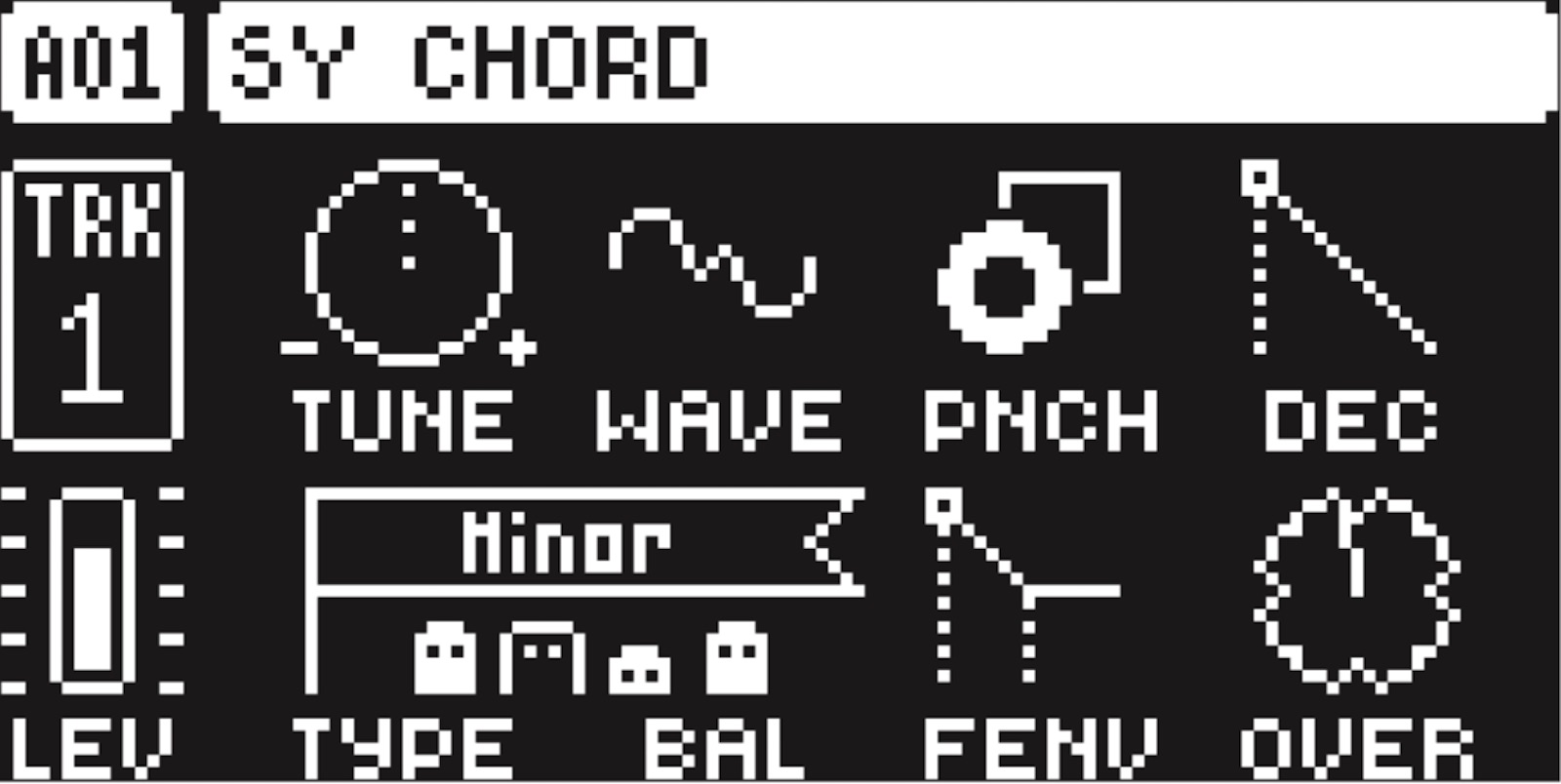
As for the Chord Machine, it's an impressively malleable and musical source of harmonic movement to supplement your beats and rhythms. It's an instant pad maker—it uses wavetable synthesis to generate sound, and provides a Balance control which smoothly morphs through different chord inversions and voicings. Though Syntakt is very much designed as a drum machine for highly rhythmic music, you could absolutely use a Chord Machine or two to craft ambient interludes between hard-hitting grooves in a performance. Also, there's actually a remarkable number of chord types available, so the music theory nerds out there are sure to have a blast here, with everything from standard diatonic chords to minor major seventh chords and dominant chords with a generous number of extended chord tones.
To make the most of melodic and tonal Machines like these, Syntakt also has a Keyboard mode which repurposes the Trig Keys for melodic playing, just as one might do on the Digitone, There's nearly 40 scales and modes to choose from, drawing from various musical traditions across the world.
The Syntakt's Analog Voices
With eight out of twelve tracks claimed by the digital voices, the remainder are reserved for Syntakt's analog voices. Aside from the digital noise generators, LFOs, and envelopes, every other aspect of the sound for these tracks is analog: the oscillators (configured and parameterized as part of a Machine), multimode filter, VCA, and panning sections. In particular, the filters are remarkably characterful and beautifully resonant, and there's a number of cool, atypical filter types besides the traditional lowpass, highpass, and bandpass—like Peak, Notch, and highpass/lowpass Shelf modes.

However, unlike the digital tracks, where all eight of them were identical, the four analog voices are further divided into three Analog Drum tracks and one Analog Cymbal track. In practice, this means that the Drum tracks and Cymbal tracks can configure their two oscillators in slightly different ways, such that they're adept for either lower-pitched, tonal elements or metallic sounds with more high frequency content. Thus, the two types of Analog tracks have different sets of Machines available to them.
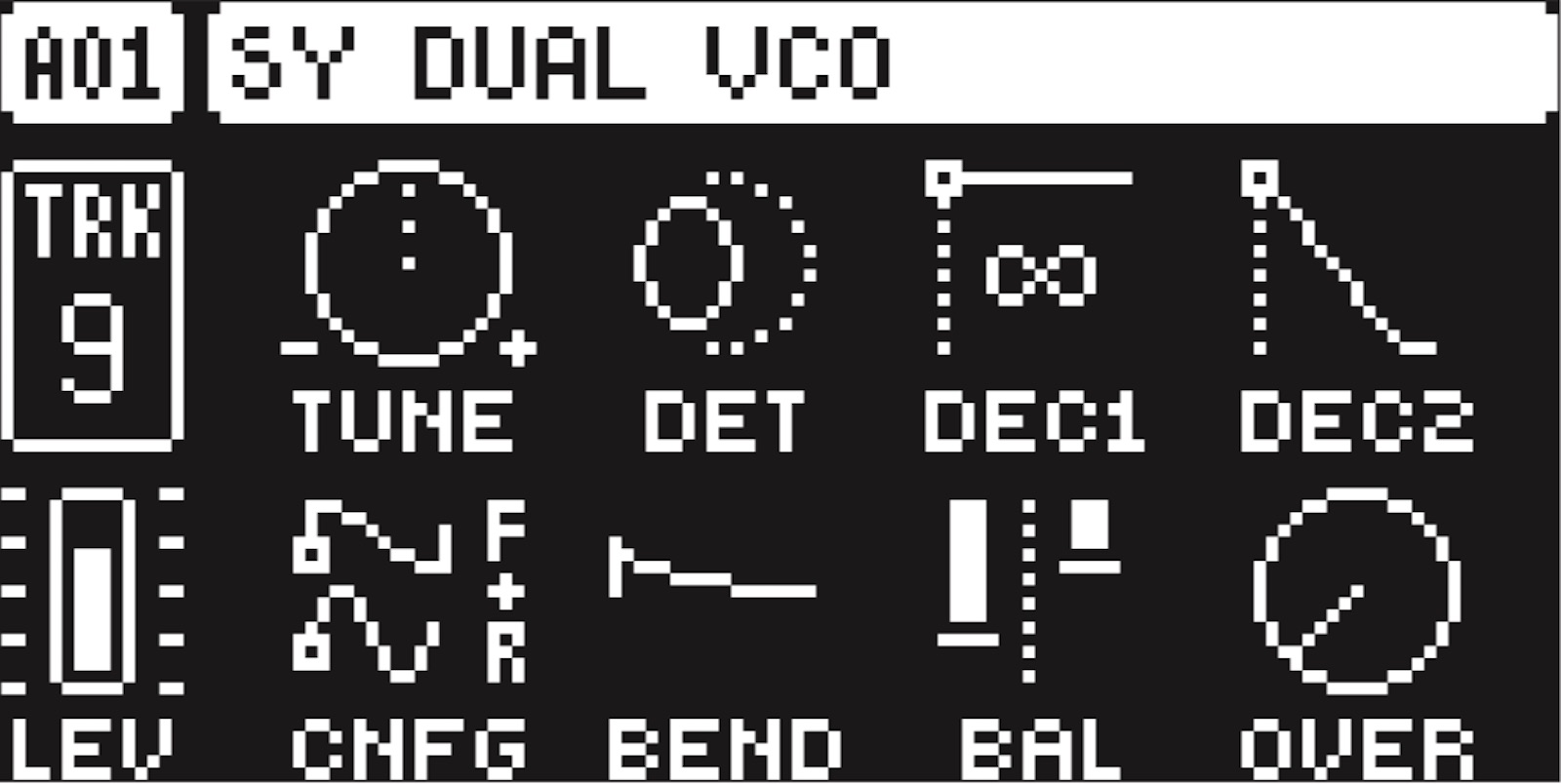
For the Analog Drum tracks, this is where you'll find juicy analog kicks, punchy snares and rimshots, plus some other fun sounds. A number of different Machines are available for each kind of drum—for kick drums alone, there are six different Machines! But, like the digital Tone and Chord Machines, there's also an SY Dual VCO Machine which similarly fills a general purpose role for melodies, basses, and the like. Notably, there's a generous number of ways the two oscillators can be configured, and as such there's a lot of different sounds to be found here—thick detuned unisons, analog FM, ring modulation, and more.
On the other hand, the Analog Cymbal track focuses on the more volatile analog oscillator configurations at the heart of traditional drum machine hi-hat, ride, crash, and cowbell sounds. In historic drum machines, these circuits often used basic oscillators and noise sources tuned to specific intervals and routed them together in clever ways to emulate the sounds of real metallic percussion instruments. Syntakt presents a number of these classic sounds with way more flexibility than would be found on the original instruments that inspired these Machines—shaping them further with the analog filter, LFOs, and sequencer gives you a vast sonic landscape to explore.
If you're looking for something a little more raw in your sound design, the Analog tracks also provide a couple of Machines that are simple impulse generators or barebones noise generators. If you're coming into Syntakt from a background in modular synthesis, you might be familiar with designing percussive voices from scratch with noise and pinged filters—that's precisely what these Machines are doing as well.
Elektron's New Trig Modifiers Explained
Knowing that Syntakt has 12 tracks, the astute observer might be wondering: what do those last four Trig Keys do? Of course, they're to be used with the sequencer, but surely they have to serve some other purpose, right? Indeed they do, and Elektron calls this new performance feature Trig Modifiers.
As the name suggests, Trig Modifiers are a way to easily apply real-time variation to manually triggered sounds from each track, and they're really handy for spicing up sequences with improvisation. If you're familiar with the concept of Scenes from the Octatrack, you could think of a Modifier as a momentary scene for firing off trigs, with four different values that can be recalled by each of the Trig Keys. Unlike Scenes, Modifiers only affect one parameter of a sound, but this makes them much more immediate in setup and performance. Another neat difference between the two is that Trig Modifiers can be recorded as part of a sequence in Live Recording mode, unlike Scenes which take priority over Parameter Locks.
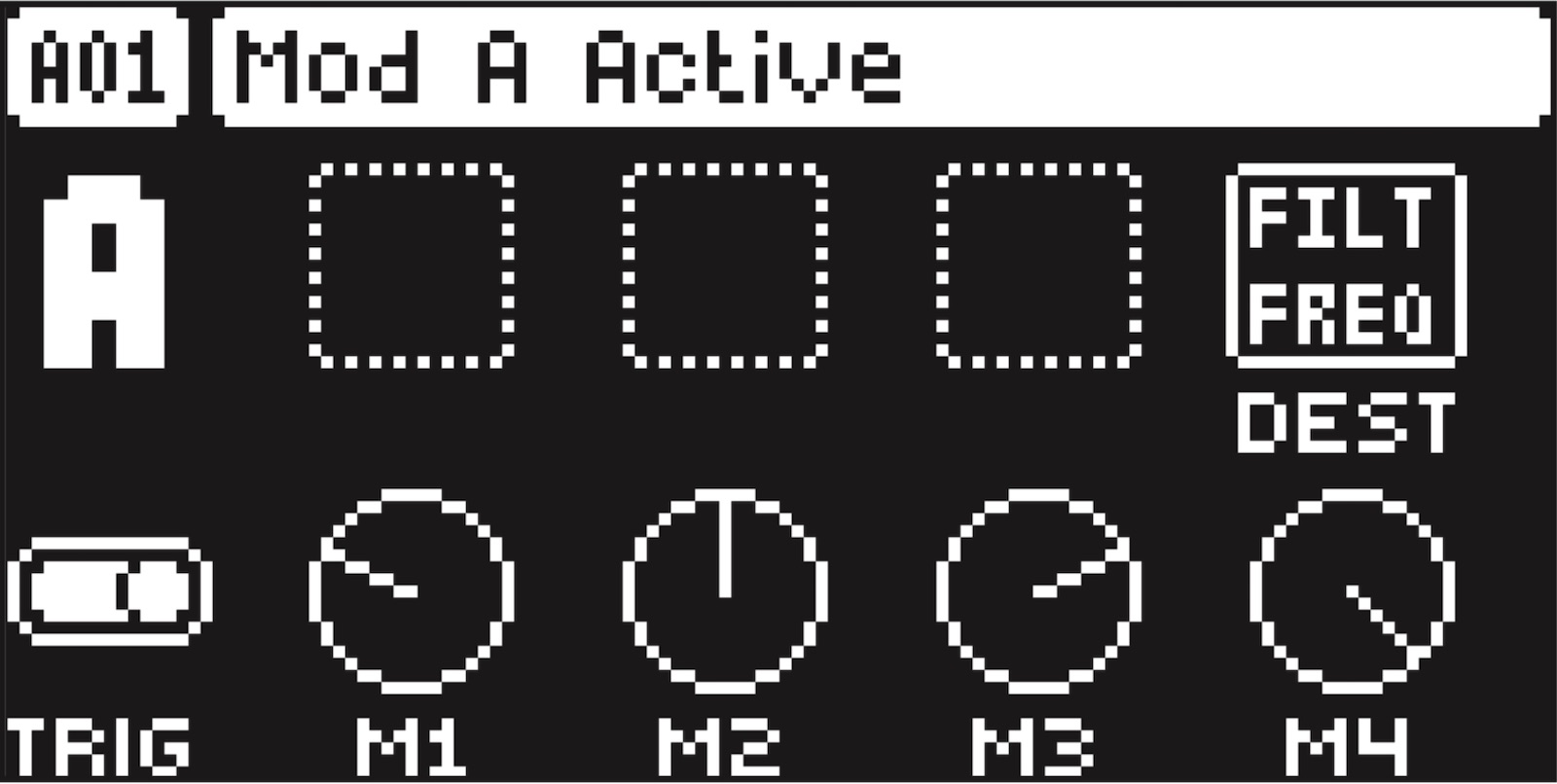
Of the four Modifiers, two of them have predefined functions: one which produces four different rates of Retrigs, and the other recalling four different Velocity levels. As for the other two Trig Modifiers, they're each assignable to one of a variety of different parameters, so long as they're available across all Machines. This includes Tuning, Decay, and Overdrive, plus most parameters from the Filter, Amp, and LFO pages. This allows you to come up with some clever performance tricks, like manually recalling four different note values to play mini-sequences or arpeggios in real-time, emphasizing longer decay times dynamically, drum rolls, and much more. Plus, Modifier settings are saved as part of a Pattern, so different assignments can be recalled as you navigate through a live set.
Getting up and running with Trig Modifiers is remarkably easy. Simply hit the Function key plus one of the Modifier buttons to select it, press Function and Up or Down to access the setup menu, and assign the four different values to be recalled by each key. From this page, you can optionally decide whether sounds from the active track get triggered when the Modifier keys are pressed, or if holding down Modifier keys applies them when any track is manually triggered. Thus, you have two different but equally powerful ways of applying Trig Modifiers to your sounds—focused and immediate activation on one track, or sonic variety and discretion across all tracks.
Syntakt's FX Track
There's one more thing which makes Syntakt stand out: the FX Track. This is a concept which originated in the Analog line, and provides interactive and dynamic control opportunities for the built-in effects. While effects found in traditional mixers and DAWs are useful, they can feel a bit static in the context of electronic music performance, and the FX Track is Elektron's answer to this problem. On a personal note, I've dreamt of a general effects counterpart to the Analog Heat for a long time, and while this certainly isn't that, the way that Elektron implemented the Syntakt FX Track is perhaps more interesting than what I had imagined for this hypothetical box.

First off, alongside the digital delay and reverb, the FX Track contains an analog processing block with a multimode filter and VCA. Each of Syntakt's 12 tracks may be independently routed into the FX Track, as well as the external inputs and even the delay and reverb. In the case of the effects and inputs, there's an option to place them before or after the Analog FX block, whether you want them to be sculpted by the filter and VCA or not. This flexibility provides some creative opportunities for mixing—pseudo sidechaining with the filter and VCA envelopes, additional filtering and phaser-like effects, and more.
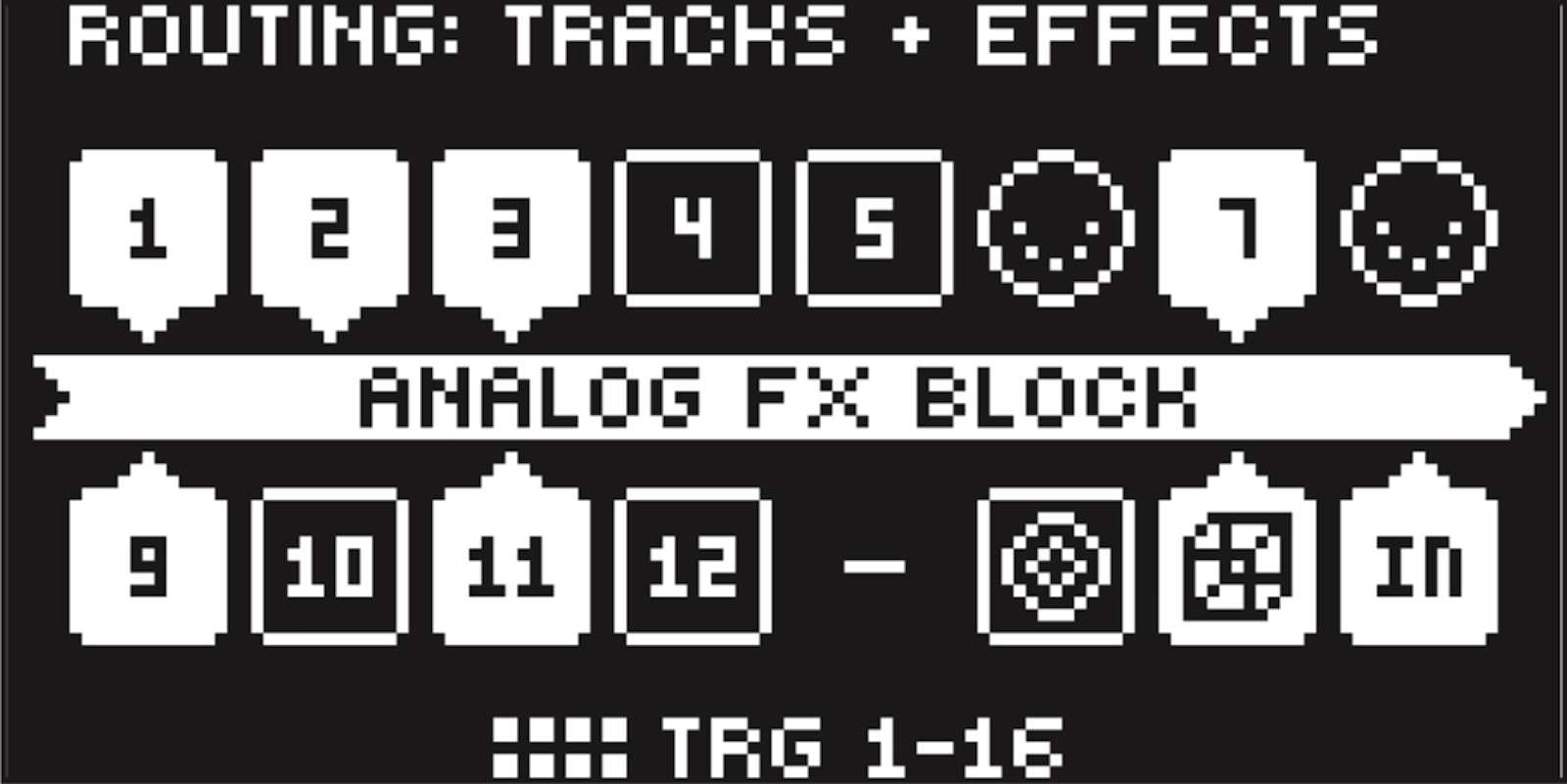
But, as the name suggests, because the FX Track is its own independent track, this means that it has envelopes, LFOs, and its own sequencer channel. The best part about this? Unlike on the Digitakt and Digitone, where the Delay, Reverb, and respective Compressor and Chorus effects are pattern-level settings accessed on secondary pages and aren't accessible by the sequencer, Syntakt does allow for sequencing and modulation of the effects! So finally, you can apply LFOs and parameter locks to the Delay and Reverb for wild sounds that you can't get out of any other Digi box—and this is seriously a cool and fun thing to do.
In some ways, the FX Track puts Syntakt into a middle ground of the Elektron catalog, with the Digitakt and Digitone on one side and the Analog Four and Rytm on the other. Functionally, Syntakt does still fit into the workflow mold of the Digi series, and remains more immediate compared to the flagship instruments. That said, borrowing the FX Track from the Analog line opens the door for Syntakt to do a lot of the cool tricks that those instruments are capable of doing, with their effects as malleable as the rest of the sound engine. It's a welcome addition to the Syntakt that gives artists yet another way to think outside of the box when composing their music.
Who is the Syntakt Designed For?
Whether this is your first drum machine or you're completing your Elektron collection, Syntakt has something to offer for everyone as a creative tool for composition, performance, and production. We think this is the entrypoint many people have been waiting for to get into the Elektron workflow—it's attractively priced in comparison to many of the premium drum machines on the market, it combines favorite features from the Machinedrum, Analog Rytm, and Model:Cycles into one powerful box, and proudly boasts plenty of its own unique twists and features.
Much as how the original versions of the Analog Four, Analog Rytm, and Octatrack created a powerful hardware setup affectionately known as the Dark Trinity, owning all three Digi boxes would also be a remarkably capable setup. Though it seems obvious to devote Syntakt to drums, Digitakt to general sample mangling, and Digitone to glassy FM pads and basses, one of the most compositionally interesting things to do with multiple Elektron instruments is exploring their overlapping areas and allowing them to trade roles. Much as a composer might write a motif across different sections of an orchestra, allowing rhythms and melodies to flow between instruments is exciting for the listener, and is a ripe fruit to be picked by the highly flexible sound engines that Elektron puts into their instruments. Alternatively, simply routing one or both of these into Syntakt's FX Track and gluing it all together with the analog filter and overdrive seems like it would be a magical way to add cohesion to the variety of sounds every device is capable of creating.
Or, slim things down to a potent pairing rather than a trio—we think combining Syntakt's drums with samples from Digitakt or Octatrack would give you plenty of creative freedom, but any combo is certainly going to be killer. Double Syntakt's analog voices with the Analog Four, or go all-in on rhythmic mayhem with an Analog RYTM. Alternatively, just add in the Analog Heat to get even more punch and sound-shaping out of Syntakt's sounds. Even outside of the Elektron bubble, Syntakt has so much potential as the centerpiece of a hardware setup. Between using a few tracks as MIDI sequencers and routing in external sources to be processed by the FX Track, there's a world of possibilities to be found with Syntakt.
Among all of us here at Perfect Circuit, even considering all of our distinct individual tastes in music and in drum machines, we can all look at Syntakt and find a lot of things to be excited about. Elektron crafts their instruments with a significant amount of effort placed into designing sound engines and performance features with staggering amounts of flexibility—not to mention that everything they make sounds great. It's already clear to us that Syntakt is yet another shining achievement in the Elektron legacy, and one that will cement itself as a future classic in their catalog.

